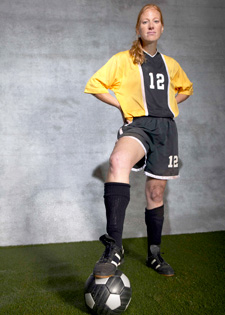 Oct. 3, 2012 – Forty years ago, President Richard Nixon signed Title IX of the Education Amendments of 1972, renamed in 2002 as the Patsy T. Mink Equal Opportunity in Education Act after the Hawaiian congresswoman who forged its path.
Oct. 3, 2012 – Forty years ago, President Richard Nixon signed Title IX of the Education Amendments of 1972, renamed in 2002 as the Patsy T. Mink Equal Opportunity in Education Act after the Hawaiian congresswoman who forged its path.
Title IX provides that, “No person in the United States shall, on the basis of sex, be excluded from participation in, be denied the benefits of, or be subjected to discrimination under any education program or activity receiving federal financial assistance.
Although specifically focused on education, over the past 40 years Title IX’s impact has been felt most prominently in the sports world. However, several issues remain unresolved.
Participation
Many associate Title IX’s main impact with increases in participation opportunities for women within sports. Recently many commentators used the 2012 Summer Olympic Games as an example of the strides made over the past 40 years.
American women won 58 medals making up 56 percent of the entire U.S. haul (104). In fact, competing as their own country, American women would have won the fifth most medals overall. This is a large increase from the Munich Summer Games 40 years ago, when American women won 22 (23 percent) of the entire medals (94) won by the U.S. team.
This participation increase may be misleading.
According to the National Federation of State High Schools, in 1971-72 there were 3,666,917 boys participating in sports, which was 93 percent of total participation. Only 294,015 (7 percent) girls participated in high school sports.
As of 2012, the number of girls competing has risen dramatically with 3,207,533 participants (42 percent of total participation), a huge increase, but still significantly less than boys’ participation 40 years ago. Boys’ participation has risen to 4,484,987 (58 percent).
At the college level these numbers continue. One measure of Title IX looks at the participation numbers of athletes of both sex and compares this rate to their rate of enrollment. According to most recent studies, while women make up close to 55 percent of enrolled college students, they make up somewhere between 41 percent and 43 percent of collegiate athletes.
This 12-14 percent difference shows that at the college level, opportunities for women are still not proportionate to their enrollment as required by law.

Financial Aid
Under Title IX and its implementing regulations, schools are required to award financial aid at levels proportionate to each sex’s participation in athletics.
Although not highly publicized, this is an area where many schools, especially at the college level, fall short. A 2010 study found that 76 percent of U.S. colleges do not provide proportionate funding. Surprising to some, 50 percent of schools provide substantially more scholarship funding to female athletes. Although this may be an attempt to make up for other disparities, it is also in clear violation of the law.
Facilities
Schools must provide equal opportunity to the members of both sexes, including in the provision of locker rooms and athletic facilities.
At the high school level, courts have compared baseball programs (with new on campus fields, proper lighting, and safe playing conditions) to softball programs (with off-site fields, no lights, and unsafe conditions), finding that schools cannot use a lack of funding as an excuse to provide lessor quality facilities to female softball players.
This same comparison has not moved to the college level yet, but it could have serious consequences if it does. The men’s basketball teams at many schools play at large NBA-level arenas, where women’s basketball teams play in smaller arenas often on campus.
Schools cannot claim that this happens due to a lack of fan support for women’s sports, as courts have made clear that until a school can show that it puts the same amount of support into female athletics (i.e. recruiting budgets, fundraising efforts, marketing efforts, etc.), it cannot provide lessor facilities for women’s teams.
Cutting Programs
When the University of Wisconsin-Madison cut its baseball team, and Marquette University cut its wrestling team, news reports focused on how the law should not allow for any opportunities to be cut. However, litigation by male advocates and former athletes throughout the 1990s and 2000s attempting to stop schools from cutting male sports and to repeal Title IX regulations related to providing proportionate sports opportunities has met with no success.
Courts have repeatedly held that cutting men’s opportunities to meet proportionality requirements is legal and that advocacy groups have no standing to sue.
A recent case may cause courts to reconsider this conclusion. In 2011, the U.S. Court of Appeals for the Fourth Circuit found that advocacy groups may have standing to sue because their members are former athletes, and the universities involved claimed that they had to cut male opportunities in order to comply with the law. Whether this grant of standing translates into an ability to overturn a university’s choice to cut male opportunities remains to be seen.
What is a Sport?
Sports organizations at both the high school and college level have a long history of creating new sports. At the NCAA level, recent emerging sports for women include rugby, sand volleyball, and equestrian. One activity that the Department of Education’s Office of Civil Rights has consistently rejected as a potential sport is cheerleading.
What most people understand as sideline cheerleading has morphed into what is known as competitive cheerleading, stunt, or acrobatics and tumbling.
Female athletes in these activities consider themselves to be athletes and want the same benefits and opportunities that other athletes receive. Several universities compete in national competitive cheerleading competitions and count these athletes in the same way that they count athletes on other athletic teams.
Courts have yet to allow schools to count these participants in order to comply with Title IX’s participation requirements. Supposed advocates for female athletic opportunities have lauded this result, even though the athletes involved then cannot receive the same support (i.e. coaching, recruiting, financial aid, etc.) as other athletes as these schools.
However, these courts have made clear that if the NCAA were to recognize competitive cheerleading as a sport, or if the activity itself formalizes its structure similar to other sports (i.e. common rules, structured championships, structured practice and competition schedules), there is no reason why it could not be counted as a real sport for Title IX purposes.
The Future
Title IX has helped athletic programs provide opportunities for women to participate in sports at unprecedented levels. However, even 40 years after its enactment, many issues remain before sports opportunities will truly be provided on an equal basis for women and men.
About the Author
Paul Anderson is the Associate Director of the National Sports Law Institute of Marquette University Law School where he is an Adjunct Professor of Law. Anderson is also chair of the State Bar of Wisconsin’s Sports & Entertainment Law Section.
